Jill Konrath's Blog, page 20
May 22, 2014
Compelling Research About How To Sell Effectively Today

I recently interviewed Brent Adamson, co-author of one of my favorite sales books, The Challenger Sale. His groundbreaking research at CEB has totally changed how we talk about sales in the past few years.
In our conversation, Brent shared the results of CEB's most recent research -- and what that means to salespeople. Here are four key takeaways on changes in the buying process and actions you can take to advance the sale:







May 20, 2014
Plan B: What to Do When Plan A Fails
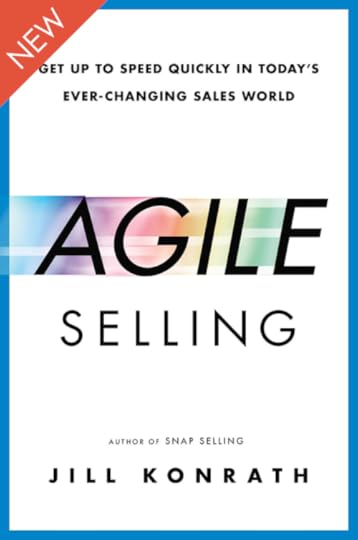
I should be jumping up and down with joy right now. After all, my new book, AGILE SELLING, is coming out next week.
But instead of busily rolling out my well-planned book launch campaign, I’m sitting in a hospital room watching my husband sleep.
Ten days ago he had quadruple bypass surgery - which went well. I expected a quick recovery because he was healthy going into it, and built my plans around it.
Then complications set in. I immediately canceled everything; family is more important than a book. After a couple of scary days, the downhill spiral stopped. Thankfully, my husband is getting better little by little every day.
But even though I'm in the midst of a family crisis, the world doesn't stop. I can’t delay the book launch date; that’s set by the publisher months in advance. Plan A is totally shot.







May 15, 2014
5 Warning Signs Your Sales Opportunity Won't Close
This article is an excerpt from my sales book, AGILE SELLING. To learn more habits of successful, agile sellers, order your copy today.
 Hope is rampant in sales. We need it to keep going - but we also need to avoid being fooled by false hope. The longer a deal stays in your sales pipeline, the less likely you are to ever close it, even if your prospect claims that he or she desperately needs your offering.
Hope is rampant in sales. We need it to keep going - but we also need to avoid being fooled by false hope. The longer a deal stays in your sales pipeline, the less likely you are to ever close it, even if your prospect claims that he or she desperately needs your offering.
Purging your pipeline regularly keeps you honest with yourself. To do so, get in touch with your long-term prospects to see what's happening. Find out if they're still serious about making a change, and if so, realistically when.
5 Warning Signs Your Sales Opportunity Won't Close
If you experience any of these warning signs, don't delude yourself into thinking they'll close. If the sales process does get stalled out and you leave it in your pipeline, the only person who loses is you.
Not sure when they'll change: If they're hemming and hawing about when they'll change, they're not a prospect right now.
Shift in Priorities: If they tell you other, more urgent priorities have emerged, they're not going to be buying in the near future.
Boss Isn't Sold: If they tell you that the boss isn't sold, it's not likely you'll get a signed contract anytime soon.
Unresponsive: If they don't respond to your calls or emails, take them off your prospect list right now.
Interested but expecting delays: You'll want to keep in touch if they are still very interested but projecting significant delays - but don't count on them.
Learning to let go is an invaluable skill in this business. It keeps you realistic about the opportunities (or lack of them) in front of you. It frees up mental energy to pursue new prospects that you have a better chance of winning. It keeps you agile.
Take ten minutes right now to review that pipeline. Don't be afraid of the purge.






May 13, 2014
Key Challenges Salespeople Are Facing Today
Recently, Brad Miller, Director of Business Development at Fathom, interviewed me about my new book, AGILE SELLING, and the key challenges salespeople are facing today. I thought you might like to listen in.
Watch the video to hear my responses to these common sales challenges:
Being Overwhelmed With Information
Brad: One of the reasons I got into sales was because of your book, SNAP Selling. I was super excited to get an uncorrected manuscript of AGILE SELLING, which is being released on May 29th, 2014. Jill, tell me about AGILE SELLING, and how it helps people deal with their own crazy-busyness.
Dealing With Failure
Brad: One of the things you said here at one of our company presentations is that there's no such thing as a failure. What do you mean by that?
Sales and Marketing Alignment
Brad: What are the challenges you see between the alignment of sales and marketing?
Salespeople as a Commodity
Brad: Sales in general has changed a lot in the last 10 years. The salesperson has become commoditized. Do you think that's the case?
Impact of Your Online Presence
Brad: We were talking about a company's and salesperson's online presence because information is so available now. If someone is going to cold call into a company and start a dialogue, what's the first thing a potential prospect or customer is going to do?
Social Selling
Brad: What is your view on "social selling"?
Sales Presentation Mistakes
Brad: Oftentimes, salespeople want to get as much information across during their sales presentations as possible, and they end up with giant presentations. What are your tips on how to shorten that up?
Evolution of Salespeople
Brad: Where does the evolution of salespeople go from here?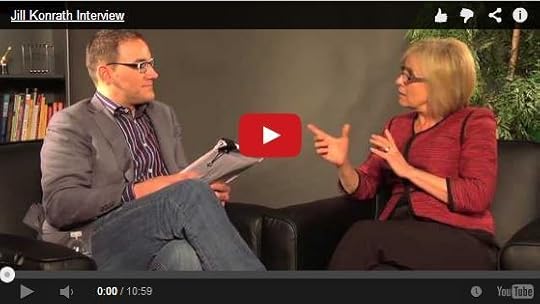






May 8, 2014
My Fear of Failing – And How I Deal With It
 Like many sellers, I look calm, cool and collected. But underneath that exterior, I've often felt far differently. If you really knew me, you’d know that I’ve worried about many things, including:
Like many sellers, I look calm, cool and collected. But underneath that exterior, I've often felt far differently. If you really knew me, you’d know that I’ve worried about many things, including:
Meeting my quota.
Succeeding in a new sales position.
Giving an important presentation.
I’ve fainted in sales calls. Once I even dropped 10 pounds in the month following a promotion to major account sales. I was so sick to my stomach that I couldn’t eat. (Not a good diet!)
During the 2000 downturn, I lost 95% of my business. It took me a couple of years to get my mojo back. I was afraid that I was totally washed up and had nothing left to offer the sales profession. (That’s probably hard for you to believe, but it’s true.)
At our core, we all worry about failing.
When you’re selling, you’re virtually guaranteed to experience lots of failure.
You’ll lose deals you should have won.
You’ll say something stupid and embarrass yourself.
You’ll fail to make your numbers.
Your forecasted prospects won’t close.
You’ll lose an important client.
But what really matters is how we handle it.
Agile sellers see failure differently from everyone else.
When a competitor wins a deal, agile sellers refuse to see themselves as a loser. When they fall into slumps, they don’t take it as an indication of their competence.
To an agile seller, failure is a natural part of the learning process. They expect to make mistakes and assume they’ll screw up.
That doesn’t mean they like failing any more than other people. But they know that when they’re learning something new, it’s going to happen.
Personally, I’ve chosen to follow their example. Please note the word chosen. It is a decision that needs to be made. Over and over again.
The key is to reframe failures.
Turn sales failures into valuable learning experiences. When you do that, everything changes. You stop being so hard on yourself. You quit trying to do things perfectly.
And you’re a whole lot less stressed – which is good, because now your brain is able to think more clearly and creatively.
If you’re struggling with something right now, you’re not failing. You just haven’t learned it yet - even if you’ve been in sales for your entire career. Things change. You have to as well.
Failure is your route to success. Remember - if you don’t learn from your mistakes, you’re bound to repeat them again and again.
(Note: Reframing Failure is just one of the four mind-sets of agile sellers. To learn more, download a preview of Agile Selling now.)






May 5, 2014
Winning With Insight: Harnessing the Power of Ideas in Selling
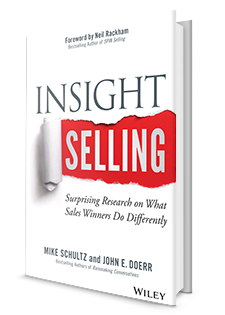
What does it take to capture the attention of today's crazy-busy, well educated prospects? They certainly don't want to take time learning about your products/services.
That's why I thought you'd be interested in my recent interview with Mike Schultz, author of the new book, Insight Selling: Surprising Research on What Sales Winners Do Differently. I hope you enjoy it.
JILL: So what exactly is "Insight Selling?
Mike Schultz: Essentially, it is harnessing the power of ideas in selling. When you can give the buyer an “aha” moment—when they learn something important—they make better decisions. We’ve defined it as follows:
Insight Selling is the process of creating and winning sales opportunities, and driving change, with ideas that matter.
Inside the definition are several important points:
You can use ideas to create sales conversations and fill the pipeline.
Ideas make a huge difference in winning sales and beating competitors.
Sellers who leverage ideas drive change—they’re not just middlemen.
And when the ideas matter to the buyers, the seller increases value.
JILL: Can you give us a brief overview of the research behind your book?
Mike Schultz: Since “The End of Solution Sales” was published in 2012 by the Harvard Business Review, there’s been a lot of disagreement in the sales world about what’s working and what’s not. We decided to study what was actually happening.
We wanted to know the answer to this question: “What are the winners of actual sales opportunities doing differently than sellers who come in second place?” To find the answer, we studied over 700 B2B purchases made by buyers responsible for $3.1 billion. We found that winners sell radically differently than second-place finishers, and that winners exhibit a specific combination of behaviors to achieve better outcomes that second-place finishers don’t.
And, in case you were wondering, solution sales is not dead. Sorry HBR, I disagree. It needs to evolve, and it’s just a piece of the whole now, but it’s not dead.
JILL: You talk about "winning with insight." I love that phrase. How did winners leverage it in the sales process?
Mike Schultz: Fundamentally in two ways:
1. Winners introduce buyers to ideas they need to know about. We call this opportunity insight. This is when the seller knows a buyer should be doing something and the buyer has little or no idea about it until the seller brings it up.
Now, I’m not saying go straight to the pitch—there’s a rhythm to getting there—but fundamentally, sellers need to get the passionate beliefs they have in their heads about certain ideas into the buyers’ heads.
2. They ask disruptive questions, pushing buyers out of their comfort zones, encouraging them to think differently. We call this interaction insight. In this sense, buyers often come to new insights on their own with the seller guiding them. The seller doesn’t just bring ideas (opportunity insight), they also spark ideas through how they lead their conversations.
JILL: One of the things you highlight is that winners are better at connecting the dots. Can you explain what you mean?
Mike Schultz: This is the whole “solution sales is not dead” thing. In our research, sellers who won did a much better job understanding buyer needs and crafting compelling solutions. I don’t care which solution or consultative sales method you subscribe to, this is the essence of the concept of selling a solution…an outcome.
We found that when sellers didn’t connect the dots, they lost! Connecting the dots, however, didn’t get them the win. It is necessary, but not sufficient. Sellers need to do more to find themselves in the winners circle.
JILL: In my experience, the majority of sellers lose to “no decision” more than all their competitors combined. How are winners getting people to change from the status quo.
Mike Schultz: Imagine for a minute a buyer wants to do something they should do, but don’t have to do. In this case, a buyer must justify a new course of action, and justify their investment in this action.
Imagine the buyer justifying this to their board of directors. They have to make an impassioned case that hits the following points:
Why we need this. Winners are much better at both connecting the dots and communicating the ROI case.
Why we should buy it from them. Winners are much more likely to convince buyers they are the best choice.
Why it will work. Winners do a better job building buyer belief and mitigating risk.
When the buyers themselves can make this case to their board…their colleagues…themselves…whoever, they take action.
Winners help buyers make this case, and thus lose fewer sales to no decision.
JILL: Mike, in your book you state: "Sales winners make strong personal relationships at more than double the rate of second place finishers." How are they doing that?
Mike Schultz: This is interesting because another Harvard Business Review article came out recently titled “Selling is Not About Relationships.” Again, I disagree. I’d say it’s not all about relationships, but relationships are certainly critical for selling success.
You can look at relationships in two ways: 1) the business relationship steeped in the mutual exchange of value, and 2) the personal relationship. Both are critical. With the business relationship, the more value you provide, the more essential you become to the buyer’s success, but sellers don’t get to this point unless the buyer likes them first. A few thoughts on personal relationships:
Don’t fear the personal relationship. Get to know people. Let them get to know you.
Don’t confuse being “liked” with seeking harmony. You can be liked and still be an assertive and forceful agent of change for a buyer.
Find ways to spend time with buyers. Relationships deepen when you spend time with people.
JILL: I love your focus on collaboration. Not a lot of people are talking about that subject, yet I think it’s crucial. How are winners collaborating differently from others?
Mike Schultz: The sellers that won were almost three times as likely to be perceived by buyers as collaborative. When we talked to buyers and asked them what collaboration meant to them, by and large what we heard boiled down to this: they believed sellers worked with them to achieve mutual goals.
When sellers practice interaction insight (described earlier), the buyers really feel the collaboration.
We also included “educated me with new ideas and perspectives,” the number one factor separating winners from second-place finishers, under the heading of collaboration. When ideas are worthwhile, they can inspire buyers to pursue new opportunities. That’s opportunity insight.
This is why we titled the book Insight Selling. The number one and number two factors separating winners from second-place finishers were “educated me with new ideas and perspectives” and “collaborated with me” in the sense of working together to achieve mutual goals.
Indeed, harnessing the power of ideas is what winners do differently than second-place finishers.
JILL: Thanks so much, Mike. Great stuff. Click here to get your copy of Insight Selling. If you order by May 10th you'll get access to exclusive high value sales resources (including an interview with me about What it Takes to Succeed in Sales Today).
The research behind it is rock-solid. And, the insights you gain from reading it will transform how you sell.
 Mike Schultz is President of RAIN Group, an industry-leading sales training and consulting company. He's also the bestselling author of Rainmaking Conversations: Influence, Persuade and Sell in Any Situation, Insight Selling: Surprising Research on What Sales Winners Do Differently, and writes for the RAIN Selling Blog. Follow Mike on Twitter at @mike_schultz.
Mike Schultz is President of RAIN Group, an industry-leading sales training and consulting company. He's also the bestselling author of Rainmaking Conversations: Influence, Persuade and Sell in Any Situation, Insight Selling: Surprising Research on What Sales Winners Do Differently, and writes for the RAIN Selling Blog. Follow Mike on Twitter at @mike_schultz.






May 1, 2014
My Boldest Sales Prediction - Ever
After writing SNAP Selling, I was continually accosted by salespeople who said,
“Your advice on selling to crazy-busy buyers works great. But, I’m frazzled too. How can you help me?”
I was stumped. I had nothing to offer since I wasn’t a time management guru.
Then one day it hit me. I was looking at things all wrong.
It wasn’t about being more productive. Instead, it was about keeping up with everything that was so overwhelming.

Customers were changing. New products and services were constantly being introduced. Companies entered new markets. Salespeople took new jobs. The economy was up. The economy was down. New technologies had to be mastered.
Salespeople even had to learn new ways to capture and keep the attention of today’s savvy prospects – at the same time they had to make their numbers.
No wonder they were frazzled.
Trying to keep on top of all that new stuff – and learning new skills at the same time was too much. And worse yet, there was no relief in sight. But not everyone was struggling; a small subset was doing quite well.
What attribute did they possess that others didn’t?
They were agile learners, quickly able to get up to speed when things changed. They could become competent in new positions in record time. They could instantly adjust to changing market dynamics.
As a result, they got quick wins, which gave them confidence, which led to more business. In essence, their short-term success was the key to their long-term success.
That’s why I’m making this bold prediction.
In today’s sales environment, your learning agility is your only sustainable competitive advantage. Master rapid learning strategies and your career success is virtually guaranteed.
Go figure. It’s not a skill anyone ever talks about. Nor is it even a sales skill. Yet it’s critical to your success. And truthfully, it can be learned.
How do I know? Because, as I explain in my new book Agile Selling, it’s my core strength. I’ve spent a lifetime mastering rapid learning. And, until recently, I never realized just how much it contributed to my personal success.
I honestly believe it’s far more important than anything I shared in Selling to Big Companies and SNAP Selling. If you loved those books, which many of you have, I know you’ll find it hard to imagine. But it’s true.
In the upcoming weeks I’ll be sharing more articles on the four aspects of agile learning that I cover in my new book:
The agile selling mind-set
How to learn new info quickly
How to pick up new skills fast
Success habits of agile sellers
Hopefully it’ll give you a good taste of what’s in Agile Selling. As you know, I truly want you to be successful. And, learning how to learn – rapidly – is the master skill, the one that dominates them all.






April 17, 2014
Words Decision Makers Love to Hear
Decision makers don't care about your porduct's speed, specifications, or efficiency. They don't care about the wonderful methodology you use.
Your offering is simply a tool. They care only about the results your offering delivers for them.
Buyers are particularly attracted to phrases that are linked to their business goals and objectives. Start speaking in these terms and you'll definitely attract their attention:
 Increased revenues or profitability
Increased revenues or profitabilityFaster time to market
Decreased costs
Improved operational efficiency
Revitalizing the organization
Enhancing customer loyalty
Increased market share
Decreased employee turnover
Improved customer retention levels
Increased competitive differentiation
Faster response time
Decreased operational expenses
Increased sales per customer
Improved asset utilization
Faster collections
Reduced cost of goods sold
Minimized risk
Additional revenue streams
Improved time-to-profitability
Increased billable hours
Reduced cycle time
Increased inventory turns
Faster sales cycles
Reduced direct labor costs
Can your business do any of these things? How about something similar? Perhaps you never really thought about your products or services from this perspective. But because this is what decision makers listen for, make sure to integrate these business-oriented terms into your value proposition.
For more details on how to create value propositions that are highly attractive to your customers, you can download my free Value Proposition Kit now.






April 10, 2014
[Video] Leverage LinkedIn Connections to Crack Into New Accounts
What strategies do I recommend for using LinkedIn to connect with others? Here are three ways that can really help you out.
Check your prospect's profile. Often, you can see what they're responsible for and even some of their objectives. You can then use this info to craft a compelling message that's aligned with what's important to them. Plus, you can find areas of common interest and potential connections.
After you've done that, check out the "Viewers of this Profile Also Viewed" section. That's where you'll find the names of other potential decision makers within the account – including their boss, co-workers and direct reports. Having these additional names gives you more ways to get your foot in the door.
Finally, check out Recommendations. Who did your prospect recommend? Who recommended her? The people you uncover here might be good contacts for you as well.
When you're trying to set up meetings in a new account, having multiple potential contacts is essential. And, it's important to learn who they are. That's the power of LinkedIn. Make sure you use it! 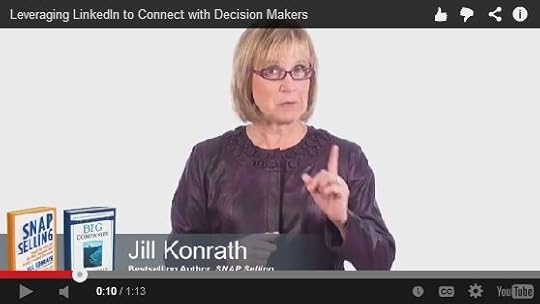






April 3, 2014
[Video] One Easy Tip for a Successful Sales Conversation
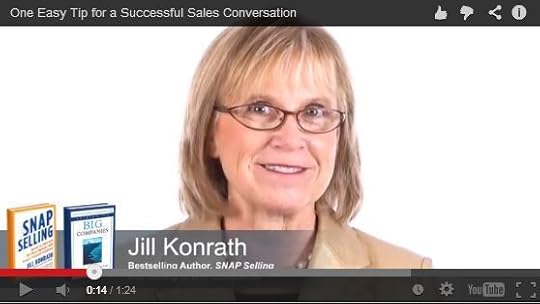
You've probably heard that being a good listener is the key to being successful in sales. While I agree that it's essential, I'm here to tell you that your ability to ask good sales questions is even more important.







Jill Konrath's Blog
- Jill Konrath's profile
- 28 followers



